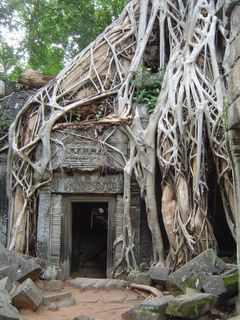Temples of Angkor in Cambodia
The temples of Angkor in Cambodia are remarkable. The world knows about Angkor Wat, but this is merely the largest and best preserved temple. In fact, there are more than 300 temples in the region around Siem Reap, most of them 800 to 900 years old, dating to the heyday of the Khmer Empire.
Lisa and I hired a guide for one of our days at the temples, and then spent additional time exploring the area on our own. Each of the temples is unique in its own way, but the most astonishing feature is the interplay between nature and man. After the temples were abandoned centuries ago, some of them were overtaken by the jungle. Today, as you wander the area, you see numerous huge, old trees with a tangled network of roots intertwined with marble pillars and sculptures that are nearly a millennium old.
Interestingly, these trees have been responsible for destroying the temples on the one hand, pushing out walls and breaking columns in half, but at the same time the trunks and roots now serve as support for these same structures, which would collapse without the weight-bearing help of the trees. Here is a picture of how the trees have overtaken some of the temples…

Angkor Wat is not one of the temples that is defined by this bond to nature, but it really is an architectural wonder. It was built in the early 1100’s, and even today is one of the largest religious structures in the world. There is a causeway that leads from the road across an old moat and up to the main building, which is an impressive sight. There is a pond of water in the front, and that is where the most famous photos are taken from.
When we were there, though, I couldn’t help but wonder what sometimes happens to great civilizations. When the temple was constructed, Angkor (the city) had about one million residents and the Khmer Empire was dominant in Southeast Asia. Yet today Cambodia is a poor and developing country. Most travelers we’ve spoken to in Asia have either loved Cambodia because the people are so friendly and welcoming, or have disliked traveling there because the poverty and begging is equally obvious and inescapable. So where did that great ancient civilization go to? How did it disappear? As we wonder, we can at least be thankful that the civilization left a legacy, in the form of the temples of Angkor.

0 Comments:
Post a Comment
<< Home